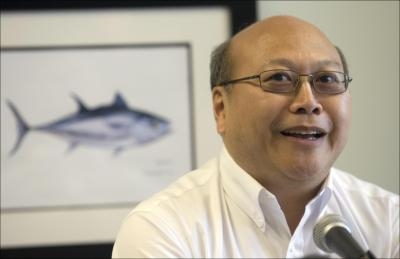
Fri. May 7 - 4:53 AM
BIO researchers take expertise to gulf oil spill
Scientists specialize in cleanup
By KELLY SHIERS Staff Reporter
 |
| Ken Lee, executive director of the Centre for Offshore Oil, Gas and Energy Research, Fisheries and Oceans Canada, speaks to reporters during a news conference at the Bedford Institute of Oceanography in Dartmouth on Thursday. Lee will head a Canadian team to help in the cleanup operations for the Gulf of Mexico oil spill. (Peter Parsons / Staff) |
In an attempt to stave off a looming environmental disaster, American officials are trying a new way to clean up the oil spewing into the Gulf of Mexico.
But they need the help of three Fisheries and Oceans Canada researchers at the Bedford Institute of Oceanography to do it.
Led by Ken Lee, Paul Kepkay and Zhen Gkai Li flew to New Orleans on Thursday on a scientific mission that has captured the worldís attention.
"I was never given an end date, so Iím not sure when this will be completed," Lee told reporters at a Dartmouth news conference before heading to the airport.
The team will be staying on an oceanographic vessel at the spill site to provide scientific expertise, at the request of the United States government.
Lee, the executive director of the Centre for Offshore Oil, Gas and Energy Research, said he has provided advice daily to the U.S. Environmental Protection Agency since last monthís deadly explosion and sinking of an oil rig in the waters off Louisiana.
Officials have tried skimming and burning the oil to contain it. Theyíre also spiking the slick, now almost the size of Cape Breton, with chemicals to try to disperse the oil and keep it from contaminating the sensitive shorelines all the way to Florida.
But no one is sure how much oil has gushed from the seabed hole or how much more will continue to do so.
Lee said chemicals similar to dishwashing detergent are used to break down oil slicks into small droplets, allowing the oil to be diluted by tides and currents to a point where it is no longer toxic. While dispersants protect seabirds and keep oil from coming ashore, the small droplets they create are more easily attacked by bacteria that break them down further.
But cleanup efforts in the Gulf are hampered by the fact that the oil is coming from the seabed. By the time it reaches the surface, itís been mixed with so much sea water, itís about the same consistency as mayonnaise, he said.
And thatís difficult to clean up.
Officials now want to try something new ó injecting the dispersants at the well hole where the oil is seeping before it mixes with water, he said.
The Nova Scotians will monitor that operation and collect data to advise officials about the cleanup efforts. He said the team will measure how well the subsurface injections are working and figure out where the dispersed oil is going.
While the project is unique, itís not the first time Lee has worked with U.S. agencies. His research has taken him around the world and many of his projects are funded by Canada and the U.S.
Lee said the options for fighting oil spills are varied.
"The secret is you have a multitude of tools. Which one do you pick to use and when? Thatís why we do the research here at BIO.
"We try to develop the science behind the decision-making to choose the tools to use. At the same time, we try to develop new tools for cleaning up oil spills."